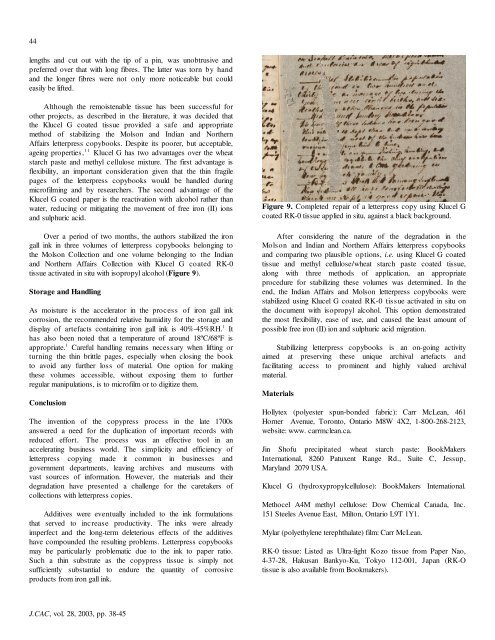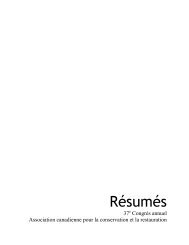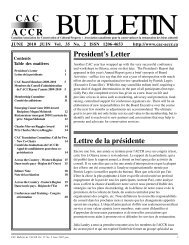Preserving Letterpress Copybooks - Canadian Association for ...
Preserving Letterpress Copybooks - Canadian Association for ...
Preserving Letterpress Copybooks - Canadian Association for ...
You also want an ePaper? Increase the reach of your titles
YUMPU automatically turns print PDFs into web optimized ePapers that Google loves.
44<br />
lengths and cut out with the tip of a pin, was unobtrusive and<br />
preferred over that with long fibres. The latter was torn by hand<br />
and the longer fibres were not only more noticeable but could<br />
easily be lifted.<br />
Although the remoistenable tissue has been successful <strong>for</strong><br />
other projects, as described in the literature, it was decided that<br />
the Klucel G coated tissue provided a safe and appropriate<br />
method of stabilizing the Molson and Indian and Northern<br />
Affairs letterpress copybooks. Despite its poorer, but acceptable,<br />
ageing properties, 1 1 Klucel G has two advantages over the wheat<br />
starch paste and methyl cellulose mixture. The first advantage is<br />
flexibility, an important consideration given that the thin fragile<br />
pages of the letterpress copybooks would be handled during<br />
microfilming and by researchers. The second advantage of the<br />
Klucel G coated paper is the reactivation with alcohol rather than<br />
water, reducing or mitigating the movement of free iron (II) ions<br />
and sulphuric acid.<br />
Over a period of two months, the authors stabilized the iron<br />
gall ink in three volumes of letterpress copybooks belonging to<br />
the Molson Collection and one volume belonging to the Indian<br />
and Northern Affairs Collection with Klucel G coated RK-0<br />
tissue activated in situ with isopropyl alcohol (Figure 9).<br />
Storage and Handling<br />
As moisture is the accelerator in the process of iron gall ink<br />
corrosion, the recommended relative humidity <strong>for</strong> the storage and<br />
display of artefacts containing iron gall ink is 40%-45%RH. 1 It<br />
has also been noted that a temperature of around 18ºC/68ºF is<br />
appropriate. 1 Careful handling remains necessary when lifting or<br />
turning the thin brittle pages, especially when closing the book<br />
to avoid any further loss of material. One option <strong>for</strong> making<br />
these volumes accessible, without exposing them to further<br />
regular manipulations, is to microfilm or to digitize them.<br />
Conclusion<br />
The invention of the copypress process in the late 1700s<br />
answered a need <strong>for</strong> the duplication of important records with<br />
reduced ef<strong>for</strong>t. The process was an effective tool in an<br />
accelerating business world. The simplicity and efficiency of<br />
letterpress copying made it common in businesses and<br />
government departments, leaving archives and museums with<br />
vast sources of in<strong>for</strong>mation. However, the materials and their<br />
degradation have presented a challenge <strong>for</strong> the caretakers of<br />
collections with letterpress copies.<br />
Additives were eventually included to the ink <strong>for</strong>mulations<br />
that served to increase productivity. The inks were already<br />
imperfect and the long-term deleterious effects of the additives<br />
have compounded the resulting problems. <strong>Letterpress</strong> copybooks<br />
may be particularly problematic due to the ink to paper ratio.<br />
Such a thin substrate as the copypress tissue is simply not<br />
sufficiently substantial to endure the quantity of corrosive<br />
products from iron gall ink.<br />
J.CAC, vol. 28, 2003, pp. 38-45<br />
Figure 9. Completed repair of a letterpress copy using Klucel G<br />
coated RK-0 tissue applied in situ, against a black background.<br />
After considering the nature of the degradation in the<br />
Molson and Indian and Northern Affairs letterpress copybooks<br />
and comparing two plausible options, i.e. using Klucel G coated<br />
tissue and methyl cellulose/wheat starch paste coated tissue,<br />
along with three methods of application, an appropriate<br />
procedure <strong>for</strong> stabilizing these volumes was determined. In the<br />
end, the Indian Affairs and Molson letterpress copybooks were<br />
stabilized using Klucel G coated RK-0 tissue activated in situ on<br />
the document with isopropyl alcohol. This option demonstrated<br />
the most flexibility, ease of use, and caused the least amount of<br />
possible free iron (II) ion and sulphuric acid migration.<br />
Stabilizing letterpress copybooks is an on-going activity<br />
aimed at preserving these unique archival artefacts and<br />
facilitating access to prominent and highly valued archival<br />
material.<br />
Materials<br />
Hollytex (polyester spun-bonded fabric): Carr McLean, 461<br />
Horner Avenue, Toronto, Ontario M8W 4X2, 1-800-268-2123,<br />
website: www. carrmclean.ca.<br />
Jin Shofu precipitated wheat starch paste: BookMakers<br />
International, 8260 Patuxent Range Rd., Suite C, Jessup,<br />
Maryland 2079 USA.<br />
Klucel G (hydroxypropylcellulose): BookMakers International.<br />
Methocel A4M methyl cellulose: Dow Chemical Canada, Inc.<br />
151 Steeles Avenue East, Milton, Ontario L9T 1Y1.<br />
Mylar (polyethylene terephthalate) film: Carr McLean.<br />
RK-0 tissue: Listed as Ultra-light Kozo tissue from Paper Nao,<br />
4-37-28, Hakusan Bankyo-Ku, Tokyo 112-001, Japan (RK-O<br />
tissue is also available from Bookmakers).





